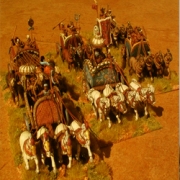Ancient India Culture in Indus Valley Civilization
Archaeology is the only source of our knowledge for the Indus valley civilization. The culture of Indus civilization is located in the Indus Valley and western India and its urbanization is based on a chalcolithic system that was marked by absence of iron.
The focal point of the Indus valley civilization remains the twin cities of Harappa and Mohenjo-daro and it is from these centres,the contours of Indus culture can be deduced. Indus society was peace loving city-dwellers and good planners as is evident by grid pattern towns, elaborate drainage system, street lights, kelp-burnt brick houses, fortifications, granaries, baths and wells.
The Indus society had a very complex social stratification, division of labour and multiplicity of crafts and industries. Urbanism was the marked feature of Indus society. It was a society that enjoyed a settled and sedentary life, where the priest and the merchant played dominant role.
The Indus society was the product of an available food surplus (wheat and barley), a fairly high level of craft industry and most important a vibrant commercial activity. The Indus society worshiped the cults of Sakti (mother Goddess) and Pasupati (Proto-Shiva) of animal-tree and stone of Phallus and Yoni, the fertility cult. They had veneration for bulls. They buried their dead.

Light horse chariotThe Indus society had an administrative organization. The uniform planning of the cities and presence of sanitary system, standard weights and measures, assembly halls, huge granaries and citadels,all points to the existence of a ruling authority.
The Indus society made considerable progressin the works of art. The Indus sculpturethat survives today makes us construct the picture of the Indus culture. The sculpture of a bearded man from Mohenjo-daro and two sand stone statuettes from Harappa, gives us a vivid account of urban culture of the Indus valley civilization. Similarly the society’s vigour, variety and ingenuity can be gleaned from the bronze dancing girl and the ivory works, in terracotta figures of animals, birdsand humanand in their pottery painted red, black and at times glazed.
The Indus society used a script where out of nearly 400 characters known to them only a few were repeated again. The inscription that has survived tells the prevalence of a high standard of urban culture.


0 Comments:
Post a Comment